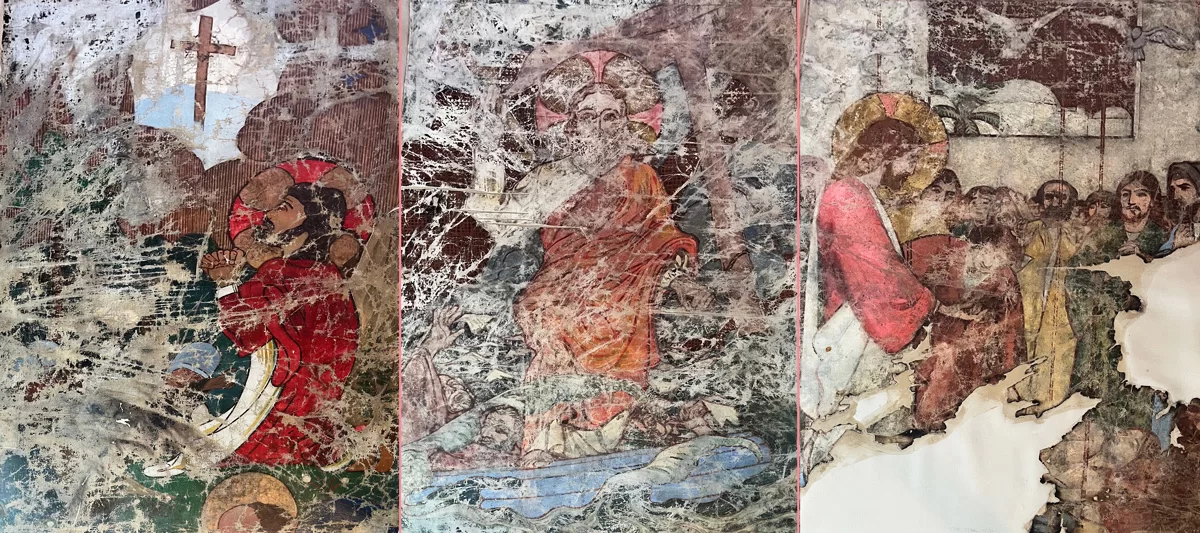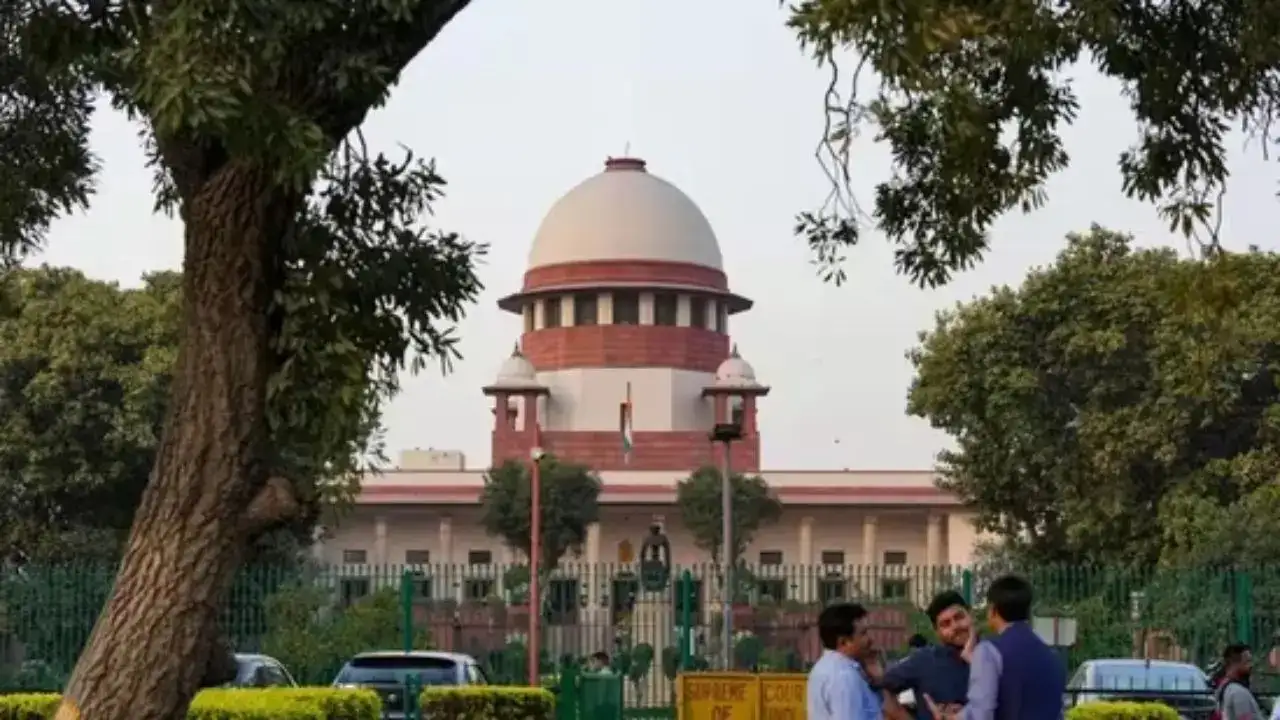Historic Toronto church, destroyed by fire, to be rebuilt as smaller structure inside remains of old building
By Matthew Puddister
Copyright anglicanjournal

New St. Anne’s will meet needs currently requiring separate buildings
St. Anne’s Anglican Church in Toronto, which featured unique Byzantine Revival architecture and irreplaceable artwork by members of the Group of Seven before its destruction by fire on June 9, 2024, will be rebuilt as a more modest structure within the remains of the old church building, its interim priest-in-charge says—fulfilling purposes currently split between two separate buildings, the former rectory and the parish hall.
Meanwhile, the parish has also managed to preserve three paintings and part of a mosaic that were damaged in the fire but not destroyed. Following a restoration process, St. Anne’s has now received back the artwork.
Since the fire, the congregation has moved to worship in the adjacent parish hall. The Rev. Judith Alltree, serving as interim priest-in-charge at St. Anne’s from June 15 to Sept. 15, 2025, says the parish received a letter in early September from Heritage Toronto, a city agency that seeks to preserve local heritage buildings. The letter says the parish must keep all existing remains from the old church building—which include its exterior walls and main entrance—as part of the rebuilding project.
The parish will therefore incorporate the rebuilt church inside the “footprint” of the old church, Alltree says. What that will look like is still up in the air; for example, the parish might incorporate a garden area between the outer walls of the old church and those of the new church.
Knowing what the base size of the new building will be allows St. Anne’s to better plan a new structure in accordance with its needs, she says.
“We will not be needing an 800-seat sanctuary, not being a huge church any longer,” Alltree says. “We don’t need that big a building. We can get all that we need in the footprint of what remains. So that’s really good news.”
Explaining what she meant by “good news”, Alltree says the original St. Anne’s—which the federal government designated a national historic site—was a massive building constructed in the early 20th century, when many Anglican churches were built to house very large congregations.
“St. Anne’s was—and continues to be—a huge presence in the Parkdale neighbourhood, both physically and for other reasons, such as the many outreach ministries,” Alltree says. “Our outreach actually continues, even though our huge building does not.”
When looking at plans for the rebuilding project, she says, the parish realized it could contain all its needs for the new church—including offices, meeting rooms, worship space, kitchen—inside the footprint of the old building. That contrasts to how it has used its property since the fire, accommodating offices in both the ministry centre, i.e. the former rectory, and the parish hall, where it houses its worship space and hosts community dinners and other events.
St. Anne’s is currently overseeing surveys of the area to determine how many layers into the ground are necessary to hold space such as offices. Alltree says the parish will be looking at designs for the rebuilt church during the two months leading up to Toronto’s diocesan synod in November, along with getting necessary construction permissions from the city and diocese.
“We do not know what the design will be like,” Alltree says. “In other words, we’re not saying we’re going to rebuild exactly as it looked like before the fire. No Byzantine dome roof … That’s not most likely going to happen. It hearkens back to a different era and it would be difficult to [rebuild] that.”
Also preserved, along with the exterior of the old church, are three pieces of artwork that were saved from the fire—“not in great condition, but they were saved,” Alltree says, adding, “It is astonishing, given the intensity of the fire, that they survived at all.”
On Sept. 11, St. Anne’s received back the artwork, which had been undergoing restoration, for the congregation to examine. The art includes parts of a cross mosaic and three murals: Christ in the Garden by Hamish Stewart-Treviranus, The Tempest by J.E.H. MacDonald of the Group of Seven and Healing of the Palsied Man by Neil McKechnie.
“What was amazing was the murals were all found at the eastern end of the building, the opposite end of where they had been mounted,” Alltree says. “Almost as if they were being protected from the worst of the fire.”
Insurance covers the cost of restoring the building, but not the artwork. As a result, the congregation will do more fundraising and applying for grants in the coming years. Repurposing some of its land for projects such as low-income housing could also provide a potential revenue stream, Alltree adds.
Deciding to move forward with the rebuilding project has revitalized St. Anne’s, she says. “We’re going to rebuild that church. That’s exciting and that’s giving focus to the parish.”
Up from the ashes
The Rev. Don Beyers, incumbent and rector of St. Anne’s until June 15, 2025, said in early June that the year after the fire was a testament to the resilience of his parish, as members sought to re-establish themselves following the destruction of the old church building.
In the immediate aftermath, volunteers worked to set up tables and chairs so the congregation could hold Sunday worship outdoors in the St. Anne’s parking lot. The choir looked for other spaces where it could practice singing. Nearby St. Thomas’s Anglican Church lent the parish liturgical vessels. Within two weeks, the congregation began holding worship within the St. Anne’s parish hall.
The official fire investigation lasted about a month. Most of the remainder of 2024, Beyers said, involved stabilization of cleanup and the ruins left.
“We dream of reincorporating what is left over there into whatever is built next,” he said, adding, “The [work] crews were amazing—were so good about trying to preserve whatever artistic element that they could … They delicately went through everything … They were even trying to save pieces of stained glass that, although fragile, were miraculously not destroyed by the fire.”
Through that delicate approach, he added, the crews also managed to find pieces of artwork by the Group of Seven members, preserving what they could.
October 2024 saw the next stage of work: ensuring that the ruins of St. Anne’s were protected from the elements over the winter months. Measures included filling in the basement with dirt to keep the foundation warm through the winter, placing housewrap over interior walls and capping brickwork to prevent water from flowing into holes, which would have damaged the building through expansion upon freezing.
“I loved talking to the crews … With the demolition crew, the cleanup crews, the heritage groups, what amazed me is though many of them were not necessarily persons of faith, there was almost this sacred sense about what they were doing,” Beyers said.
“They knew that what they were doing was an important act. They demonstrated the utmost respect and I would almost use the word ‘reverence’ for what they were doing. It was quite moving.”
In December, the discernment committee began its work of planning rebuilding efforts, guided by its architectural advisor—consulting with parishioners on what ministries they thought were important should St. Anne’s build a new church, as well as with community partners such as LOFT.
After the fire, choir member Isabella Favaro launched a fundraising campaign through GoFundMe to help rebuild St. Anne’s. As of Sept. 12, 2025, the campaign had raised $50,097, more than halfway towards its $100,000 goal.
Beyers expressed gratitude to Favaro, while noting her GoFundMe was a private initiative and that St. Anne’s itself had not yet launched an official fundraising campaign. In the meantime, the parish had also received thousands of dollars in donations from other groups and Christian communities, with Beyers noting strong support by Roman Catholics in particular.
Parish in discussions with community partners to re-imagine property—but priority is rebuilding church
Beyers said in early June that his parish was talking to community partners like LOFT Community Services—a neighbouring non-profit that supports people dealing with mental and physical health changes, poverty, homelessness and addiction issues—about ways they might be able to use revamped parish property once rebuilding efforts are complete.
A discernment committee made up of St. Anne’s parishioners, lay people, and a representative from the diocese of Toronto were holding monthly consultations with an architect, Beyers said. Potential ideas after a new church is built include subsidized housing or building an underground parking garage to turn the current parking lot into a green space.
“It’s really an opportunity for the parish, I think, to do something that would express not only our faith values, but also our values around creation care, social justice, and serving community,” Beyers said.
Even before the fire, he said, St. Anne’s had been talking about ways to open up the church more to the community, since it had a large building that often sat empty. At the height of the COVID-19 pandemic, for example, Beyers reached out to the city of Toronto offering to use the church as a vaccination site.
“I think churches need to be more creative and intentional about using our space more wisely and for the greater good of the community as well,” Beyers said.
Speaking to the Anglican Journal in late August, however, Alltree said it was clear from discussions with parish members that while housing was important, their primary function was as a parish church and their primary goal was to rebuild the church as soon as possible. “We are first and foremost a church congregation,” Alltree said.
Beyers also emphasized that while he supported opening up parish facilities to the wider community, St. Anne’s would “remain intentional about creating sacred space … The church isn’t just an auditorium. It’s also a sacramental sight and a tool, as the church has always been, to arouse people’s senses of the holy.”



